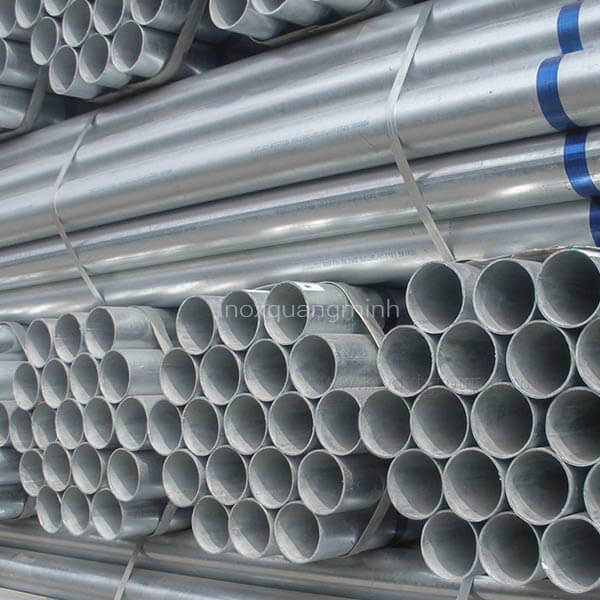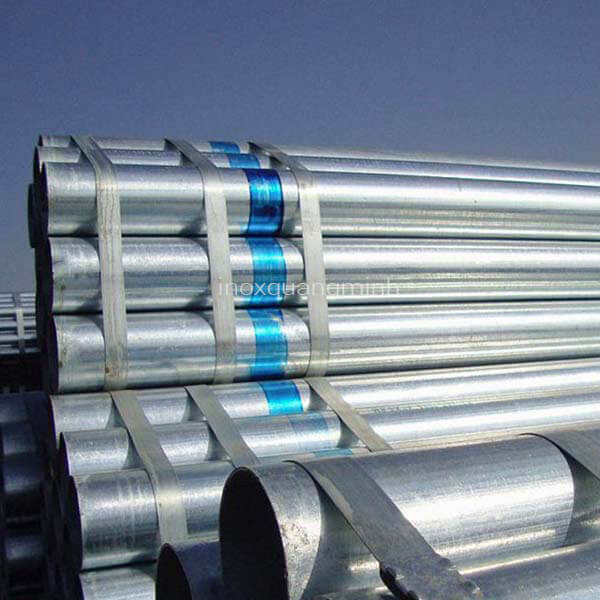Sanitary stainless steel pipe, also known as food grade stainless steel pipes, are pipes made from typical stainless steel materials such as stainless steel 304, 316.
In addition, the tube is also polished inside and outside the tube wall to avoid adhesion from plaque, which is an ideal place for bacteria and germs to live and grow. That is why microbial stainless steel pipes are often chosen for widespread use in the food, pharmaceutical and medical industries.
Currently, microbiological tubes are being used more widely and are one of the top choices of factories and workshops.
Classification of microbiological tubes at QMS
Sanitary stainless steel pipes on the market today are divided into two most common types: stainless steel welded pipes and stainless steel molded pipes 304, 316. Based on the production method, stainless steel welded pipes and stainless steel molded pipes both have different characteristics. Helps customers easily choose the right type of tube for their intended use
Production process of stainless steel welded pipes
Sanitary stainless steel pipes are produced starting from sheets of 304, 316 stainless steel material, then cut into rolled stainless steel strips to form a tube shape and then used to weld together. After that, the raw stainless steel pipes will be trimmed, smoothed, polished and then the finished product will be microbial stainless steel pipes that meet prescribed standards.

Stainless steel pipe production process
Compared to stainless steel welded pipes, the production process of stainless steel molded pipes will be more complicated and has more steps. The initial materials for pipe production are 304 stainless steel billets or 316 stainless steel billets. These billets will be heated at very high temperatures to be able to shape the pipe shape and diameter as required. Continuing, the raw tube will go through the next stages such as cutting the tube and polishing the inside and outside of the tube to be able to produce a microbiological tube product that meets quality requirements.
Basic characteristics of microbial stainless steel
Shine on the tube surface
Sanitary stainless steel pipes have roughness and low gloss, usually 180 Grid or more. The tube surface is dust-resistant so it is easy to clean by wiping.
Anticorrosion
Microbial stainless steel pipes have good corrosion resistance in acidic, sulfuric, hydrochloric, alkaline chloride, tartaric, sulfate, and formic acid environments.
High hardness
Stainless steel pipes have the ability to resist certain external forces without causing the pipes to deform.
Ability to change shape and size at normal temperature. Microbiological stainless steel pipes are not destroyed when subjected to forces such as stretching and tightening relative cross-sections.
Compare 304 microbiological stainless steel pipe and 316 microbiological stainless steel pipe
Microbiological stainless steel pipes 304, 304L
304 microbiological stainless steel pipe is a type of pipe made from 304 stainless steel and has properties suitable for different needs. Microbial stainless steel 304 also has a variety of types including 304L, 304H, 304LN, etc. However, the most commonly used on the market are 304 and 304L microtubes.
The low carbon content in 304L stainless steel pipes helps avoid harmful carbide rain on welds. Stainless steel 304L is also suitable when pipes and accessories need to be connected by welding or in seawater environments.
304L microbial stainless steel pipes are commonly used in the beer, wine, drinking water, milk processing industries, etc. Systems using microbial stainless steel pipes can be fermentation tanks, tanks, and pipeline systems. substances, valve equipment
Microbiological stainless steel pipes 316, 316L
Microbiological stainless steel pipe 316 is resistant to surface pitting and crevice oxygen in chloride environments at normal temperatures. Stainless steel 316 has a high carbon content that increases its resistance to corrosion, resistance to chlorite solutions, resistance to oxidation and high temperatures up to 870-925 degrees Celsius.
316L microtubes contain low carbon content, 316L stainless steel has better resistance to carbon rain than 316 stainless steel.

Application of microbial stainless steel
Microbial stainless steel is widely used in industry and life. Microbial stainless steel pipes are mainly used in the food, medical, chemical industries,…
In life:
- Production of kitchen utensils: Knives, scissors, forks, cup holders, chopsticks,…
- In healthcare: Medical syringes, medicine trays, food trays and other medical tools,…
- In interior decoration: Stair handrails, door handles, railings,…
In industry:
- Producing microbiological pipes and accessories: microbiological shrinks, microbiological tubes, microbiological stainless steel shortening, microbiological stainless steel shortening,…
- Materials for construction of microbial stainless steel pipes.
If you are currently still wondering about finding a supplier of quality stainless steel pipes at optimal prices for your business, then don’t hesitate to look for QMS.
QMS – Quang Minh Stainless Steel is currently one of the units that has a solid foothold in the stainless steel industry. In particular, QMS is also a leading distributor of 316 stainless steel pipes and 304 stainless steel pipes ordered according to different customer requirements to suit each purpose of using the microbial piping system.
Customers need advice and quotes on industrial stainless steel products, microbial stainless steel pipes 304, 316. Please contact QMS directly via hotline: 0906.345.304 or send a message via zalo. Technical staff at QMS are pleased to advise and provide products to you.









